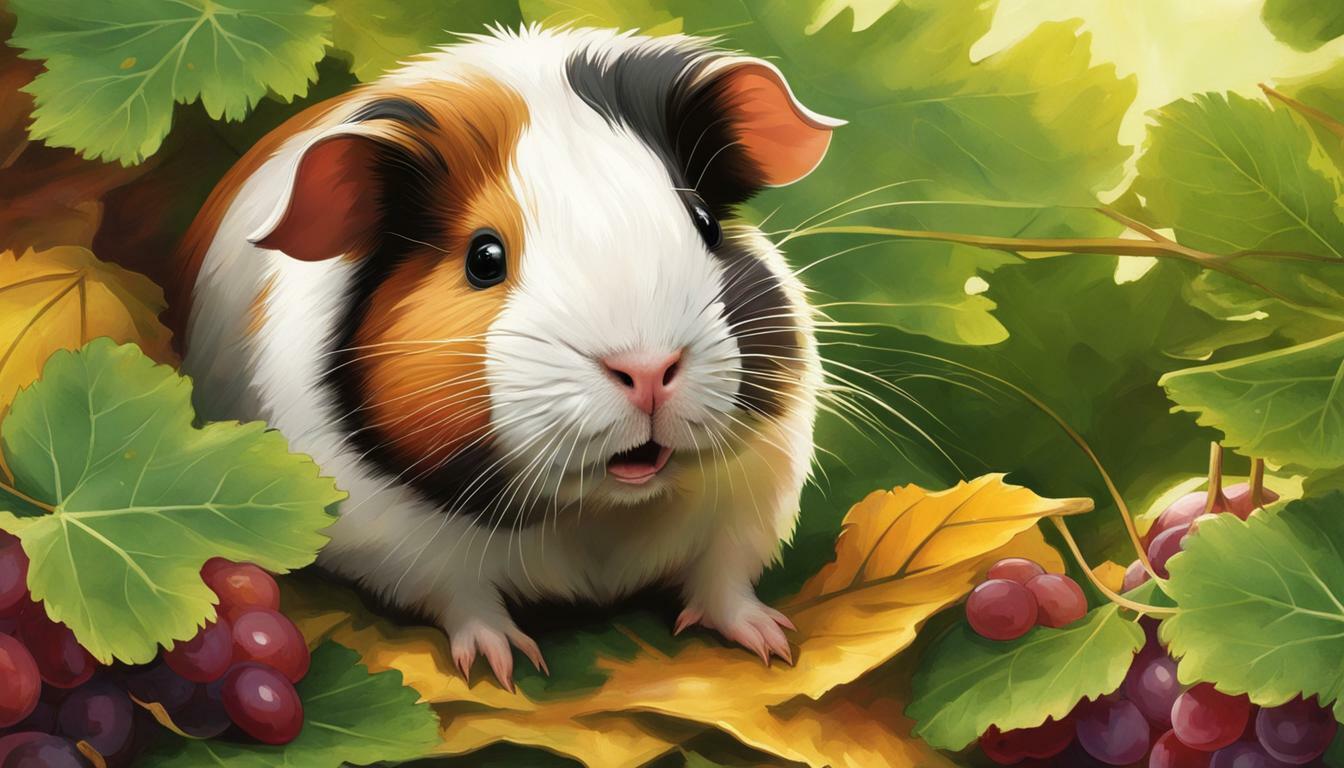If you’ve ever wondered if guinea pigs can eat grape leaves, read on to find out the answer! Guinea pigs have specific nutritional needs, and it’s important to understand what foods are safe and beneficial for them. In this section, we will explore whether guinea pigs can consume grape leaves and discuss their nutritional needs.
Key Takeaways:
- Guinea pigs can eat grapes, but moderation is key due to their high sugar content.
- Seedless grapes that have been washed are the best option for guinea pigs.
- Guinea pigs can eat the skin of grapes, but not the leaves or vines.
- Grapes provide several health benefits for guinea pigs, such as vitamin C, energy, heart health, and good eye health.
- Consult a veterinarian before adding grapes to your guinea pig’s diet to ensure it is appropriate for their specific needs.
The Guinea Pig Diet: Understanding Their Nutritional Needs
Before we dive into whether guinea pigs can eat grape leaves, let’s first understand their overall nutritional needs. Guinea pigs are herbivores, which means their diet primarily consists of plant-based foods. They require a diet that is high in fiber, low in sugar, and rich in essential nutrients to support their overall health and well-being.
Table 1: Nutritional Requirements for Guinea Pigs
| Nutrient | Recommended Daily Intake |
|---|---|
| High-quality hay | Unlimited |
| Fresh vegetables | About 1 cup per day |
| Pellets | 1/8 to 1/4 cup per day |
| Vitamin C | About 10-30 mg per day |
In addition to fresh, high-quality hay, guinea pigs should be offered a variety of fresh vegetables on a daily basis. Leafy greens such as kale, romaine lettuce, and parsley are excellent choices. They should also be given a small amount of guinea pig pellets, which provide additional nutrients and should be specifically formulated for guinea pigs.
Vitamin C is essential for guinea pigs as they are unable to produce it on their own. Therefore, it is important to provide them with foods that are high in vitamin C. Foods such as bell peppers, strawberries, and oranges can be given in small quantities to ensure they meet their daily vitamin C requirements.
It’s important to note that while grape leaves may not be an appropriate food for guinea pigs, there are plenty of other nutritious options available. By providing a balanced diet that meets their specific nutritional needs, you can help ensure that your guinea pig stays healthy and happy.
Can Guinea Pigs Eat Grapes?
To determine if guinea pigs can eat grape leaves, it’s important to understand if they can eat grapes themselves. Guinea pigs can indeed eat grapes, but it’s essential to feed them in moderation. Grapes are high in sugar, so it’s best to offer small amounts as an occasional treat rather than a regular part of their diet.
When feeding grapes to your guinea pig, make sure to remove any seeds and wash the grapes thoroughly. Seedless grapes are recommended to prevent choking hazards. While guinea pigs can eat the skin of grapes, they should not consume the leaves or vines. It’s important to note that the skin of red grapes can be tougher and more challenging for them to digest.
Grapes provide several health benefits for guinea pigs. They are a great source of vitamin C, which is vital for their overall health and immune system. Grapes also provide energy and contribute to heart health and good eye health. However, it’s crucial to remember that guinea pigs have sensitive digestive systems, and too many grapes can lead to obesity and other health issues.
Before introducing grapes or any new food into your guinea pig’s diet, it is recommended to consult with a veterinarian. They can provide specific guidance based on your guinea pig’s individual needs and ensure a balanced diet. Remember, variety is key, and a well-rounded diet should consist of hay, fresh vegetables, and a quality guinea pig pellet food.
Table: Can Guinea Pigs Eat Grapes?
| Grapes | Can Guinea Pigs Eat? |
|---|---|
| Seedless Grapes | Yes, in moderation |
| Grape Leaves | No |
| Grape Vines | No |
| Grape Skin | Yes, but red grape skin may be tough to digest |
| Grape Seeds | No, remove before feeding |
| Grape Juice | No |
| Frozen Grapes | No, too cold for their stomachs |
| Baby Guinea Pigs | No, stick to mother’s milk, grass, and water |
Nutritional Benefits of Grapes for Guinea Pigs
Before we discuss grape leaves, let’s explore the nutritional benefits that grapes offer to guinea pigs. While guinea pigs should consume grapes in moderation due to their high sugar content, these juicy fruits can provide several health benefits when included as part of a balanced diet.
Grapes are an excellent source of vitamin C, a vital nutrient for guinea pigs. This vitamin helps support their immune system, promotes healthy skin, and aids in the absorption of iron. Additionally, grapes provide energy to guinea pigs through their natural sugars, helping to fuel their daily activities.
In addition to vitamin C, grapes contain antioxidants that contribute to heart health and protect against cell damage. The natural compounds found in grapes can also promote good eye health in guinea pigs, keeping their vision sharp and clear.
| Nutritional Benefits of Grapes for Guinea Pigs |
|---|
| Excellent source of vitamin C |
| Provides energy |
| Aids in heart health |
| Promotes good eye health |
While grapes offer these benefits, it’s important to remember that moderation is key. Feeding too many grapes can lead to obesity and other health issues in guinea pigs. It is always recommended to consult a veterinarian before introducing grapes or any new food into your guinea pig’s diet, as each guinea pig may have different dietary needs.
In conclusion, grapes can be a nutritious addition to a guinea pig’s diet when fed in moderation. These delicious fruits provide vitamin C, energy, and contribute to heart and eye health. Remember to always wash and remove any seeds from grapes before feeding them to your furry friend. By considering their nutritional needs and consulting with a veterinarian, you can ensure the overall well-being of your guinea pig.
Moderation is Key: Grape Consumption for Guinea Pigs
While grapes can be beneficial for guinea pigs, it’s crucial to understand the importance of moderation when including them in their diet. Guinea pigs are herbivores and require a balanced diet that consists primarily of hay, fresh vegetables, and a small portion of fruits. Grapes, being a sweet fruit, contain a significant amount of sugar, which can lead to weight gain and other health issues if consumed excessively.
When offering grapes to your guinea pig, it is important to choose seedless grapes and wash them thoroughly before feeding. Guinea pigs can eat the skin of grapes, as it provides fiber and additional nutrients. However, it’s best to avoid giving them grape leaves or vines, as these parts of the plant can be harmful to their digestive system.
Grapes offer some health benefits for guinea pigs, including a boost of vitamin C, which is essential for their overall health and immunity. They also provide energy for their active lifestyles and contribute to heart health and good eye health. However, it’s important to remember that grapes should only be given as an occasional treat and not as a staple in their daily diet.
| Grape Consumption Guidelines for Guinea Pigs |
|---|
| Choose seedless grapes |
| Wash grapes before feeding |
| Avoid giving grape leaves or vines |
| Feed grapes in moderation |
| Consult a veterinarian before adding grapes to their diet |
Red grapes are safe for guinea pigs to eat, but it’s important to keep the serving size small. The skin of red grapes can be tougher than other grape varieties, so it’s advisable to remove the skin or cut grapes into smaller pieces to make them easier to chew and digest. Additionally, guinea pigs should not be given grape juice, as it is high in sugar and lacks the necessary fiber found in whole grapes.
Lastly, it’s important to note that frozen grapes should not be given to guinea pigs. The extreme cold temperature can be too harsh for their sensitive stomachs and may cause discomfort or harm. As for baby guinea pigs, they should stick to their mother’s milk, grass, and water, and avoid consuming grapes until they are older and their digestive systems are more developed.
Can Guinea Pigs Eat Grape Leaves or Vines?
Now, let’s address the question of whether guinea pigs can safely eat grape leaves or vines. While guinea pigs can consume grapes in moderation, it is important to note that grape leaves and vines are not suitable for their diet. Guinea pigs are herbivores and their main source of nutrition should come from hay, fresh vegetables, and a small amount of fruits. Grape leaves and vines do not provide the essential nutrients that guinea pigs need for optimal health.
When it comes to grapes, it is important to feed them in moderation due to their high sugar content. While guinea pigs can eat the skin of grapes, it is best to provide them with seedless grapes and wash them before feeding. However, the leaves and vines of grapes can be harmful to guinea pigs and should be avoided.
Grapes are known to offer some health benefits to guinea pigs. They contain vitamin C, which is essential for their overall well-being. Grapes also provide energy, contribute to heart health, and support good eye health. However, it is crucial to remember that guinea pigs have specific dietary requirements, and too many grapes can lead to obesity and other health issues. It is always a good idea to consult with a veterinarian before introducing grapes into your guinea pig’s diet.
| Grape-related Considerations for Guinea Pigs | |
|---|---|
| Grape leaves and vines | Not suitable for guinea pigs |
| Grape skin | Can be consumed, but the skin of red grapes may be too tough |
| Grape juice | Should not be given to guinea pigs |
| Frozen grapes | Avoid feeding frozen grapes as they can be too cold for their stomachs |
| Baby guinea pigs | Should not be fed grapes; stick to mother’s milk, grass, and water |
In conclusion, while guinea pigs can enjoy the occasional grape as a treat, it is important to feed them in moderation to prevent any health issues. Grape leaves and vines are not suitable for their diet, and it is always best to consult with a veterinarian for proper guidance on incorporating grapes into your guinea pig’s nutrition plan. Remember to prioritize their main sources of nutrition, such as hay and fresh vegetables, to ensure their overall well-being.
Red Grapes: Safe for Guinea Pigs?
If you’re considering adding red grapes to your guinea pig’s diet, let’s find out if they are safe for consumption. Guinea pigs can eat grapes, including the skin, but it’s important to remember that moderation is key. Grapes are high in sugar, so they should be given sparingly to avoid potential health issues such as obesity or digestive problems.
When feeding your guinea pig red grapes, it is best to choose seedless grapes and wash them thoroughly before offering them as a treat. While guinea pigs can consume the skin of grapes, it’s important to note that the skin of red grapes can be tougher compared to other grape varieties, so it may not be as easily digested by your furry friend.
It is crucial to avoid feeding guinea pigs grape leaves, grape vines, or grape juice. These parts of the grape plant can be harmful to their health. Additionally, frozen grapes should not be given to guinea pigs as they can be too cold for their sensitive stomachs. Always prioritize your guinea pig’s well-being and consult with a veterinarian before introducing any new foods into their diet, including grapes.
| Safe: | Not Safe: |
|---|---|
| Seedless Grapes | Grape Leaves |
| Washed Grapes | Grape Vines |
| Grape Skin (with caution) | Grape Juice |
While grapes do offer certain health benefits for guinea pigs, such as providing vitamin C, energy, heart health, and good eye health, it is crucial to remember that they should be given in small quantities. It’s always better to focus on a balanced guinea pig diet that consists mainly of hay, fresh vegetables, and pellets recommended by a veterinarian. Remember, baby guinea pigs should not be fed grapes and should stick to their mother’s milk, grass, and water for optimal growth and development.
Serving Size and Precautions for Feeding Grapes
To ensure the well-being of your guinea pig, let’s discuss the recommended serving size and precautions when feeding grapes. Guinea pigs can enjoy grapes as a tasty treat, but it’s important to remember that they should only be given in moderation. Grapes are high in sugar, so consuming too many can lead to obesity and other health issues.
When offering grapes to your furry friend, opt for seedless grapes and make sure to wash them thoroughly before feeding. While guinea pigs can safely eat the skin of grapes, it is important to note that they should not consume the leaves or vines. Additionally, the skin of red grapes can be tougher than that of green grapes, so it’s best to stick to the latter.
To give you an idea of the appropriate serving size, a general guideline is to offer one or two small grape pieces as an occasional treat. Remember, the main component of a guinea pig’s diet should consist of hay, fresh vegetables, and pellets that provide the necessary nutrients for their overall well-being.
It’s always a good idea to consult with a veterinarian before introducing grapes or any new food into your guinea pig’s diet. They can provide personalized guidance based on your pet’s specific needs and ensure their diet remains balanced and healthy.
| Precautions: | Recommended Serving Size: |
|---|---|
|
Offer one or two small grape pieces as an occasional treat. |
Remember, grapes should be given as an occasional treat, not a significant portion of your guinea pig’s diet. By following the recommended serving size and taking necessary precautions, you can ensure your furry friend enjoys the benefits of grapes while maintaining a healthy and balanced diet.
Other Grape-related Considerations for Guinea Pigs
While grapes can be a tasty treat for guinea pigs, there are a few more grape-related considerations to keep in mind. Guinea pigs can consume the skin of grapes, but it’s important to note that the skin of red grapes can be tougher and harder to digest for them. Therefore, it’s best to stick with seedless and lighter-skinned grapes to ensure easier digestion.
When introducing grapes into a guinea pig’s diet, moderation is key. Feeding too many grapes can lead to obesity and other health issues. It’s advisable to consult with a veterinarian before including grapes in your guinea pig’s diet to ensure it aligns with their specific nutritional needs.
Table: Types of Grapes Suitable for Guinea Pigs
| Grape Type | Suitability for Guinea Pigs |
|---|---|
| Seedless Grapes | Recommended for easier digestion |
| Lighter-skinned Grapes | Preferred over darker-skinned for easier digestion |
Note: Guinea pigs should not consume grape leaves or vines, as they are not suitable for their digestive system. Additionally, grape juice should not be given to guinea pigs as it can be too concentrated and high in sugar. Frozen grapes are also not recommended as they can be too cold for their sensitive stomachs.
It’s important to remember that baby guinea pigs should not be fed grapes. They should primarily rely on their mother’s milk, grass, and water for proper nutrition and growth. As always, if you have any concerns or questions about your guinea pig’s diet, it’s best to consult with a veterinarian who specializes in small animals.
Baby Guinea Pigs and Grapes
If you have a baby guinea pig, it’s important to understand their specific dietary needs and whether grapes are suitable for them. While grapes can be enjoyed by adult guinea pigs in moderation, it is recommended to avoid feeding them to baby guinea pigs, especially during the early stages of their development.
At a young age, baby guinea pigs rely heavily on their mother’s milk for nutrition. Their digestive system is still developing, and introducing solid foods too early can cause digestive issues and discomfort. It is best to wait until they are at least three to four weeks old before introducing any new foods, including grapes.
During this period, baby guinea pigs should primarily consume grass and water, gradually transitioning to a balanced diet of hay, fresh vegetables, and a limited amount of pellets as they grow older. This diet provides them with essential nutrients for healthy growth and development. Until they are fully weaned, it is important to consult with a veterinarian to ensure they are receiving the appropriate diet for their age and size.
| Suitable Foods for Baby Guinea Pigs | Avoid Feeding Baby Guinea Pigs |
|---|---|
|
|
Remember, always prioritize the health and well-being of your baby guinea pig by following the guidance of a veterinarian. They can provide specific recommendations tailored to your guinea pig’s individual needs. By feeding them a proper diet and gradually introducing new foods at the appropriate time, you can ensure they grow into happy and healthy adults.
Conclusion
After exploring the topic of whether guinea pigs can eat grape leaves, we hope you now have a clear understanding of their dietary needs and considerations. Guinea pigs can indeed eat grapes, but it is important to feed them in moderation due to their high sugar content. Opt for seedless grapes and make sure to wash them thoroughly before serving.
While guinea pigs can enjoy the skin of grapes, it is crucial to note that they should not consume the leaves or vines. Grapes provide several health benefits for guinea pigs, including a good source of vitamin C, energy boost, and promoting heart and eye health. However, overfeeding grapes can lead to obesity and other health issues, so it is always wise to consult a veterinarian before introducing grapes into your guinea pig’s diet.
Red grapes are safe for guinea pigs to munch on, but remember to keep the serving size small. Avoid giving your pet grape leaves or grape juice, as these are not suitable for their consumption. While guinea pigs can eat grape skin, the skin of red grapes can be tough for their delicate digestive system. Additionally, frozen grapes should be avoided as they can be too cold for their stomachs.
It’s important to mention that baby guinea pigs should not be fed grapes. They should stick to their mother’s milk, grass, and water for proper nourishment. By being mindful of these considerations and providing a balanced diet, you can ensure the health and well-being of your adorable guinea pig companion.
FAQ
Can guinea pigs eat grape leaves?
No, guinea pigs should not eat grape leaves. They can eat grapes themselves, but not the leaves or vines.
Can guinea pigs eat grapes?
Yes, guinea pigs can eat grapes, but they should be fed in moderation due to their high sugar content.
What are the nutritional benefits of grapes for guinea pigs?
Grapes provide several health benefits for guinea pigs, including vitamin C, energy, heart health, and good eye health.
How much grapes should I feed my guinea pig?
It is recommended to consult a veterinarian for guidance on the appropriate serving size of grapes for your guinea pig.
Can guinea pigs eat grape skin?
Yes, guinea pigs can eat grape skin, but the skin of red grapes can be too tough for them.
Can I give my guinea pig grape juice?
No, guinea pigs should not be given grape juice. Stick to feeding them whole grapes in moderation.
Are frozen grapes safe for guinea pigs?
No, frozen grapes should not be given to guinea pigs as they can be too cold for their stomachs.
Can baby guinea pigs eat grapes?
No, baby guinea pigs should not be fed grapes. They should stick to their mother’s milk, grass, and water.




